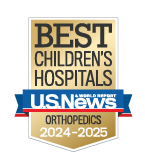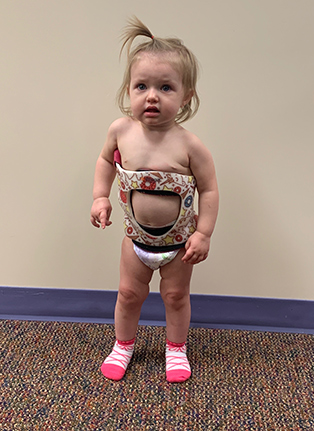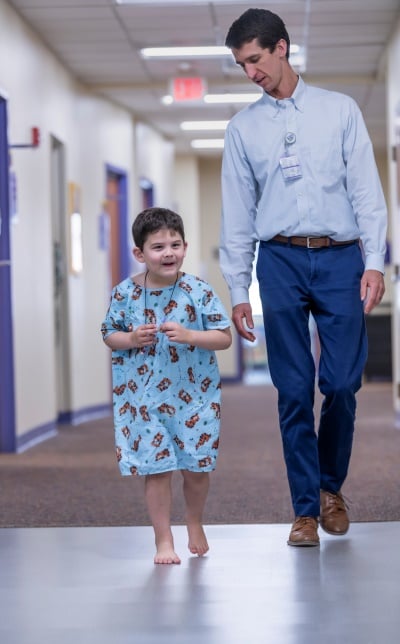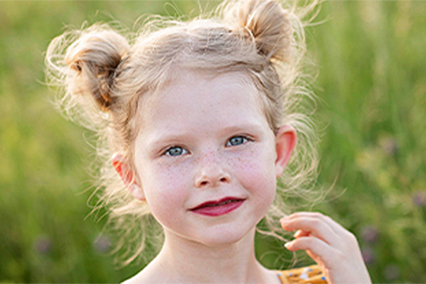Bracing Options for Adolescent Idiopathic Scoliosis
Nationally ranked by U.S. News & World Report


Bracing Options for Adolescent Idiopathic Scoliosis
Nationally ranked by U.S. News & World Report


What is a spine brace for scoliosis?
Spine braces are the most common nonsurgical option for adolescent idiopathic scoliosis—a condition in which the spine curves more than usual during a young teen’s major growth spurt. While there are different styles and types of braces, all of them are custom fitted to your child. Wearing a brace can help slow the progression of a curve and ultimately, avoid possible need for spine surgery.
Using an expertly-made brace designed by an experienced orthotist gives your child the best odds of avoiding surgery in the future. Children’s Mercy partners with Hanger Clinic to provide an in-house orthotist that specializes in bracing for scoliosis. Regular visits with your orthotist in Hanger Clinic is a very important part of brace treatment. Hanger Clinic orthotists specialized in bracing for scoliosis are also available near our Children's Mercy Kansas location.
How does the brace work?

A spine brace works by using gentle pressure in key places on the trunk of the body to bring the spine back towards a straight alignment. Wearing the brace, sometimes together with physical therapy and exercise, helps prevent a spinal curve from progressing.
Braces are designed to be worn under clothing, with a specially designed seamless body sock made of coolmax material, thin shirt or tank top underneath. If your doctor recommends full-time usage, this can mean up to 16-20 hours each day in the brace. While this is an adjustment, most kids find that eventually, they become comfortable wearing the brace at home, school, and overnight. Usually, kids can remove the brace during bathing, swimming, sports and PE, or simply to take a break from it for a little while each day.
Finding the best fit for the brace
Your orthotist is the person who will design and build the actual brace for you. It’s their job to make sure you get the best fit so you have the most potential to benefit from your device. But progress improves significantly when kids closely follow their doctor’s instructions for wearing the brace.
Your child’s provider may recommend a compliance monitor in the brace to help them track your usage between visits.
Choosing the right brace
Your Spine Care team—including your orthopedic doctor, nurse practitioner, orthotist and radiologist—will all work together with you to create a brace that’s just right for your child. We’ll start by doing a thorough examination of your child and taking x-rays and 3D images of your child with our EOS low-dose, fully body imaging technology. Then, we’ll discuss the options for bracing.
Early onset scoliosis: Quinn's story
Why is Quinn Liberman smiling? The 7-year-old is finished with serial Mehta casting and moving to the next phase of treatment at Children’s Mercy for her scoliosis—Rigo Cheneau bracing. To celebrate, she took time for a unique photo shoot documenting her journey.

Living with a scoliosis brace
Online and in person support groups for kids with scoliosis can be helpful to families. Here, your child can talk with others who are going through the same thing and older teens with scoliosis who serve as mentors.
One helpful youth-led organization is called Curvy Girls, which serves the 80% of young people with scoliosis who are girls.
The National Scoliosis Foundation also provides great resources that many patients and families have found helpful.
Life with a scoliosis brace can be challenging. Many kids are diagnosed with scoliosis around middle school age, which is already a time of transitions and increased self-awareness. It will feel strange at first when your child can’t bend over to pick up a dropped pencil or has to adjust their usual sleep position. But most kids find they adapt pretty quickly and can continue their favorite activities with some modifications.
Your Spine Care team at Children’s Mercy will help your family navigate these challenges. We can connect you with pediatric mental health and counseling resources if your child is struggling with adjusting to the brace, reactions from peers, or other concerns.
The benefits of braces for scoliosis
The greatest benefit to wearing the brace is having a much higher chance of avoiding surgery in the future. The goal of bracing is to keep your child’s curve from progressing and in some cases, improve the curve for better alignment of the spine.
Because the brace is custom-fitted to your child, they will usually need a new one every 12-18 months to accommodate their growth over time. Once they have completed their growth, we will slowly decrease the amount of time they wear the brace each day until they are completely independent from it.
Speak the language: Scoliosis bracing terms
- Cobb angle – A way to measure the degree of curvature of the spine from an x-ray image to determine if the curve is getting better or worse over time.
- EOS Imaging – The EOS system is a low-dose imaging system that allows your Spine Care team to capture 3D pictures of your child’s spine. It can capture images while the person is standing, sitting, or bending over to give your doctor a clearer picture of the spine, and uses ultra-low doses of radiation for your child’s safety.
- Orthotist – An orthotist is a specially-trained health professional who designs and builds medical supportive devices. In order to become an orthotist, you must get a master's degree, a residency and certification.
- Rigo Cheneau 3D Bracing – This type of scoliosis brace was originally developed by Dr. Jacques Cheneau and later improved by Dr. Manuel Rigo. It is designed to improve spinal alignment in three dimensions, and works together with Schroth physical therapy exercises to optimize effectiveness. Children’s Mercy is one of only a few locations in the U.S. to offer these types of braces.
- Schroth method – This is a physical therapy approach named for its founder, German physical therapist Katharina Schroth. The Schroth method helps strengthen muscles to improve posture, reduce pain, and prevent progression of the curve in people with scoliosis.
- Spine Care
- Bracing Options for Scoliosis
- Growing Rods
- Halo Gravity Traction
- iSpine Clinic
- Mehta Casting
- Microdiscectomy for Disc Herniation
- Outreach Services
- Spinal Fusion
- Spine Care Consultations
- Spine Surgery: What to Expect
- Spondylolysis and Spondylolisthesis
- Vertebral Body Tethering
- Meet the Team
- Orthopedics
